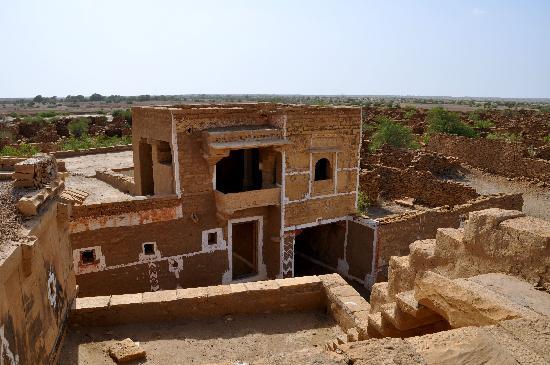Kuldhara Village
Jiyai, Rajasthan 345001
Located at a distance of 18 kms. from Jaisalmer

Kuldhara Village is an abandoned village in the Jaisalmer district of Rajasthan, India. Established around 13th century, it was once a prosperous village inhabited by Paliwal Brahmins. It was abandoned by the early 19th century for unknown reasons, possibly because of dwindling water supply, or as a local legend claims, because of persecution by the Jaisalmer State’s minister Salim Singh.
Gradually, it acquired reputation as a haunted site, and the Rajasthan State Government decided to develop it as a tourist spot.
The former village site is located about 18 km south-west of the Jaisalmer city. The village was located on a 861 m x 261 m rectangular site aligned in the north-south direction. The township was centered around a temple of the mother goddess. It had three longitudnal roads, which were cut through by a number of latitudnal narrow lanes.
The remains of a city wall can be seen on the north and the south sides of the site. The eastern side of the town faces the dry-river bed of the small Kakni river. The western side was protected by the back-walls of man-made structures.[
The Kuldhara village was originally settled by Brahmins who had migrated from Pali to Jaisalmer region.These migrants originating from Pali were called Paliwals. Tawarikh-i-Jaisalmer, an 1899 history book written by Lakshmi Chand, states that a Paliwal Brahmin named Kadhan was the first person to settle in the Kuldhara village. He excavated a pond called Udhansar in the village.
The ruins of the village include 3 cremation grounds, with several devalis (memorial stones or cenotaphs). The village was settled by the early 13th century, as indicated by two devali inscriptions. These inscriptions are dated in the Bhattik Samvat (a calendar era starting in 623 CE), and record the deaths of two residents in 1235 CE and 1238 CE respectively.
By the 19th century, the village had been deserted for unknown reasons. Possible causes proposed include lack of water and the atrocities of a Diwan (official) named Salim Singh (or Zalim Singh).
By 1815, most of the wells in the village had dried up. By 1850, only the step-well and two other deep wells were functional. When S. A. N. Rezavi surveyed the village in the 1990s, the only water remaining at the site was the stagnant water at some portions of the dried-up river bed. The dwindling water supply would have greatly reduced agricultural productivity, without a corresponding reduction in tax demands from the Jaisalmer State. This could have forced the Paliwals to abandon Kuldhara. A local legend claims that Salim Singh, the cruel minister of Jaisalmer, levied excessive taxes on the village, leading to its decline.
As stated earlier, the historical records suggest that the population of the village declined gradually: its estimated population was around 1,588 during 17th-18th century; around 800 in 1815; and 37 in 1890. However, a variation of the legend claims that the village was abandoned overnight. According to this version, the lecherous minister Salim Singh was attracted to a beautiful girl from the village. He sent his guards to force the villagers to hand over the girl. The villagers asked the guards to return next morning, and abandoned the village overnight. Another version claims that 83 other villages in the area were also abandoned overnight.
Tourism
The local legend claims that while deserting the village, the Paliwals imposed a curse that no one would be able to re-occupy the village. Those who tried to re-populate the village experienced paranormal activities, and therefore, the village remains uninhabited.
Gradually, the village acquired reputation as a haunted place, and started attracting tourists. The local residents around the area do not believe in the ghost stories, but propagate them in order to attract tourists. In the early 2010s, Gaurav Tiwari of Indian Paranormal Society claimed to have observed paranormal activities at the site. The 18-member team of the Society along with 12 other people spent a night at the village. They claimed to have encountered moving shadows, haunting voices, talking spirits, and other paranormal activities.
In 2006, the government set up a “Jurassic Cactus Park” at the site for botanical studies.
In 2015, the Rajasthan government decided to actively develop the village as a tourist spot. The project is being undertaken as a public-private partnership with Jindal Steel Works. The plan includes establishment of visitor facilities such as a cafe, a lounge, a folk-dance performance area, night-stay cottages and shops..
Source : wikipedia
https://www.youtube.com/watch?v=HpCen2F8Xuk
Story of the village
Reviews


Rate this article